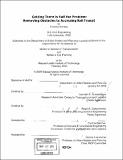Getting there is half the problem : removing obstacles to accessing rail transit
Author(s)
Switkes, Frances, 1978-
DownloadFull printable version (26.23Mb)
Other Contributors
Massachusetts Institute of Technology. Dept. of Urban Studies and Planning.
Advisor
Kenneth E. Kruckemeyer and Ralph A. Gakenheimer.
Terms of use
Metadata
Show full item recordAbstract
People can arrive at a station using a variety of different transportation modes including walking, biking, taking a bus or driving. Each access mode interfaces with transit in a different way. The layout and design of the station area affect how people reach the station and may attract or dissuade riders from using specific access modes or even whether to take transit at all. Improving transit accessibility benefits those people currently using transit and also makes it more attractive to people who may currently choose another mode for travel by providing another attractive mode choice, helping improve transit ridership and customer satisfaction. Different features and design elements that affect the safety, security, directness, weather protection and other supportive details of accessing transit are evaluated in this thesis. These elements extend from the station into the surrounding community. Since the transit agency does not control much of this infrastructure, it must work with other agencies to make these improvements. A suggested framework is developed to provide guidance at how a transit agency can effectively prioritize different station area improvements and how they can work with other agencies to efficiently implement these improvements. The number of people that will benefit and the potential for improvement should be considered when prioritizing projects. Projects that have lower priorities should be completed if there is an opportunity to incorporate them into other projects being done either by the transit agency or another agency. Design cases have been completed for Roosevelt Station in San Juan, Puerto Rico and Jefferson Park Station in Chicago, Illinois. Improving the pedestrian environment, including developing continuous, well-maintained sidewalks, is the most pressing need at Roosevelt Station. Jefferson Park needs to focus on the conflicts between modes created by the current design such as discouraging pedestrians from walking through the bus area, creating a pedestrian crossing in front of the station and improving dropoff access. Working with other agencies is important for both transit agencies.
Description
Thesis (M.C.P. and S.M.)--Massachusetts Institute of Technology, Dept. of Urban Studies and Planning, 2003. Includes bibliographical references (p. 169-173).
Date issued
2003Department
Massachusetts Institute of Technology. Department of Urban Studies and PlanningPublisher
Massachusetts Institute of Technology
Keywords
Urban Studies and Planning.